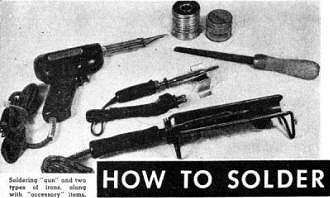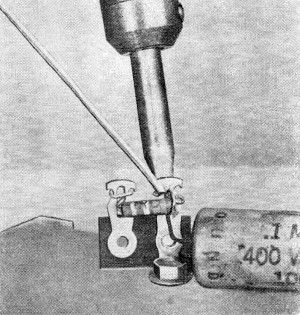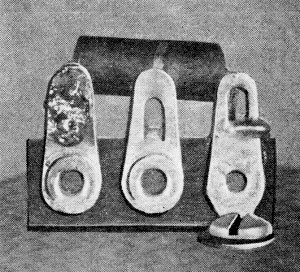|
April 1955 Popular Electronics
 Table of Contents Table of Contents
Wax nostalgic about and learn from the history of early electronics. See articles
from
Popular Electronics,
published October 1954 - April 1985. All copyrights are hereby acknowledged.
|
Proper soldering is almost
as much of an art form as it is a technical skill. Having been through numerous
soldering classes in my career, starting with electrical vocational courses in high
school, then again in USAF technical school, and other times while working as a
technician and engineer, I always exercise care in making solder joints. Proper
preparation - including both tinning of mating surfaces and a means to prevent the
joint members from moving during cool-down - is of utmost importance for assuring
a nice, smooth, shiny joint with just the right amount of solder. Lead-free solders
do not tend to produce the level of shininess as do the good old 60-40 type tin-lead
solders, but you can still make a nice looking joint. This might be more information
than you want to know about me, but I even strive for perfection in solder joints
in copper pipes and fittings used in plumbing work. Call me a masochist, eco-villain,
or worse, but I still use PbSn solder for plumbing joints just to get the shiny
joints!
How to Solder

Soldering "gun" and two types of irons, along with "accessory" items.
Poorly soldered connections are often responsible for poorly functioning and
inoperative equipment. Since good soldering is actually easier to do than poor soldering
the amateur should do three things: he should follow the basic rules of good soldering,
he should learn the difference between a poorly soldered joint and a good one, and
he should practice soldering different types of connections until he acquires the
"feel" of his iron.
The ten rules for good soldering are:
Select the right equipment for the job: Essential soldering tools include a soldering
"gun" or soldering iron and stand, solder, paste flux, and a file.
Care should be taken to select an iron suited to the work. Too large an iron
may be hard to handle and may deliver too much heat, burning the insulation. Too
small an iron, on the other hand, may not deliver enough heat to the work, making
it impossible to flow solder into the joint. A 60 to 100 watt iron with a 1/4" to
3/8" pyramid tip is best for most radio and electronic work. However, for work with
hearing aids, miniature radios, remote control equipment, and similar small items
using fine wire, a 25 to 50 watt iron or soldering "pencil" is preferred. On the
other hand, for work involving large wire and considerable soldering to a chassis,
a 150 to 250 watt iron may be required.

Correct soldering technique. The iron is held against part until
hot enough to melt solder when applied to heated junction.

The three types of mechanical connections used in soldering.
(A) For permanent installations. (B) For work where some changes may have to be
made. (C) A "lap" joint for temporary work.

Correctly (right) and incorrectly (left) soldered connections.
The latter type can cause electrical and mechanical troubles.
Soldering "guns," while more expensive than irons, are easier to use, use less
power since they consume power only when in actual use, require virtually no warm-up
time, have a small tip suitable for radio wiring, and, generally, have small lamps
which spotlight the work. A 100 to 150 watt soldering gun is a good choice for electronic
work.
Solder is available in many grades and in two types, wire and bar. The most popular
grades are 40-60, 50-50, and 60-40. The first figure refers to the percentage of
tin and the second to the percentage of lead in the alloy. In general, the higher
the percentage of tin, the lower the required soldering temperature. For radio and
electronic work, 50-50 or 60-40 wire solder with a rosin core is recommended. Never
use acid core solder in electronic wiring.
Fluxes are used to remove the thin film of oxidized metal that forms on the surface
of the work as well as to prevent additional oxidation when the metal is heated
prior to soldering. Although flux core solder is used for most wiring, a small can
of paste flux is handy to have around for tinning leads, tinning the iron tip, and
similar work. Use a non-corrosive flux.
A small fine-cut file should be available for removing pits and smoothing the
tips of soldering irons. The file should not be used unless the copper tip of the
iron is pitted and then only enough of the metal should be filed away to leave a
smooth, shiny surface.

For tight spots, an "extension" can be added to soldering iron
by means of copper bus bar.
Clean the metals to be soldered: All grease, dirt, corrosion, or enamel must
be removed from the surface of the metal prior to soldering. Use steel wool, sandpaper,
a file, a knife, wire brush, or any similar tool to remove the dirt and grease.
Keep the soldering iron tip clean and well tinned: If the tip of the iron is
not clean, the film of oxidation formed will act as insulation and prevent the proper
conduction of heat to the joint. To tin an iron, first make sure the tip is free
from corrosion and pits. If the tip is badly pitted, it will have to be filed. Allow
the iron to heat until its tip is hot enough to melt solder then flow solder over
the end of the tip. In some cases it may be necessary to rub the tip against a metal
plate (such as the top of a tin can), applying a little solder as this is done.
Finally, wipe off excess solder with a heavy cloth, leaving the tip bright and shiny.
Don't tin the entire tip: When using the iron, occasionally check for proper
tinning. Try to keep a thin film of solder on the tip of the iron at all times.
Heat the joint, not the solder: To solder a joint, hold the tip of the iron against
the joint until the joint is hot enough to melt the solder - then apply the solder
to the joint.
Don't try to solder unless the iron is really hot: Make sure the iron is hot
enough to melt solder instantly when it is touched to the tip before trying to solder
a joint. Let the heat do the work. Apply only enough pressure to the work so that
good contact is made between the iron tip and the joint. Then solder quickly.
Posted July 12, 2020
(updated from original post on 10/11/2013)
|














